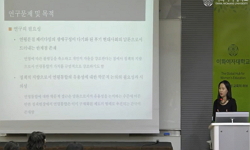The present study disentangled the genuine effect of verbal IQ as well as each of the control variables (age, gender, and race) on juvenile delinquency. A final sample size of 422, 10- to 12-year-old youths from the Children of the National Survey of ...
http://chineseinput.net/에서 pinyin(병음)방식으로 중국어를 변환할 수 있습니다.
변환된 중국어를 복사하여 사용하시면 됩니다.
- 中文 을 입력하시려면 zhongwen을 입력하시고 space를누르시면됩니다.
- 北京 을 입력하시려면 beijing을 입력하시고 space를 누르시면 됩니다.
https://www.riss.kr/link?id=A104984313
-
저자
Tammy Nickell (Children's Service Investigator Missouri Department of Social Services) ; 조역일 (University of Central Missouri) ; 이완희 (가천대학교)
- 발행기관
- 학술지명
- 권호사항
-
발행연도
2017
-
작성언어
English
- 주제어
-
등재정보
KCI등재
-
자료형태
학술저널
-
수록면
195-216(22쪽)
-
KCI 피인용횟수
0
- DOI식별코드
- 제공처
-
0
상세조회 -
0
다운로드
부가정보
다국어 초록 (Multilingual Abstract)
The present study disentangled the genuine effect of verbal IQ as well as each of the control variables (age, gender, and race) on juvenile delinquency. A final sample size of 422, 10- to 12-year-old youths from the Children of the National Survey of Youth 79 secondary data were used. We employed a logistic regression analysis, reporting that the main independent variable, IQ, and two of the three control variables (gender and race) were predictive of juvenile delinquency. The current study took on great importance because it further extended our knowledge of the biological theory which
참고문헌 (Reference)
1 Mears, D. P., "What is the effect of IQ on offending?" 44 : 1280-1300, 2013
2 Farrington, D., "Violent Crime:Assessing Race and Ethnic Differences" Cambridge University Press 213-237, 2003
3 Pinker, S., "The blank slate : the modern denial of human nature" Viking 2002
4 Herrnstein, R. J., "The bell curve: Intelligence and class structure in American life" Free Press 1994
5 Beaver, K., "The association between county-level IQ and county-level crime rates" 39 (39): 22-26, 2011
6 Ingram, F., "The PPVT-R : Validity as a quick screen of intelligence in a post-acute rehabilitation setting for brain-injured adults" 54 (54): 877-884, 1998
7 Steinberg, L., "Should the science of adolescent brain development inform public policy?" 64 : 739-750, 2009
8 Moreno, S., "Short-Term Music Training Enhances Verbal Intelligence and Executive Function" 22 (22): 1425-1433, 2011
9 M. Steketee, "Sex Differences in the Predictors of Juvenile Delinquency: Females Are More Susceptible to Poor Environments; Males Are Influenced More by Low Self-Control" SAGE Publications 29 (29): 88-105, 2013
10 Lisa M. Gatzke-Kopp, "Serious delinquent behavior, sensation-seeking and electrodermal arousal" Springer Nature 30 (30): 477-486, 2002
1 Mears, D. P., "What is the effect of IQ on offending?" 44 : 1280-1300, 2013
2 Farrington, D., "Violent Crime:Assessing Race and Ethnic Differences" Cambridge University Press 213-237, 2003
3 Pinker, S., "The blank slate : the modern denial of human nature" Viking 2002
4 Herrnstein, R. J., "The bell curve: Intelligence and class structure in American life" Free Press 1994
5 Beaver, K., "The association between county-level IQ and county-level crime rates" 39 (39): 22-26, 2011
6 Ingram, F., "The PPVT-R : Validity as a quick screen of intelligence in a post-acute rehabilitation setting for brain-injured adults" 54 (54): 877-884, 1998
7 Steinberg, L., "Should the science of adolescent brain development inform public policy?" 64 : 739-750, 2009
8 Moreno, S., "Short-Term Music Training Enhances Verbal Intelligence and Executive Function" 22 (22): 1425-1433, 2011
9 M. Steketee, "Sex Differences in the Predictors of Juvenile Delinquency: Females Are More Susceptible to Poor Environments; Males Are Influenced More by Low Self-Control" SAGE Publications 29 (29): 88-105, 2013
10 Lisa M. Gatzke-Kopp, "Serious delinquent behavior, sensation-seeking and electrodermal arousal" Springer Nature 30 (30): 477-486, 2002
11 Wong, T., "Risk factors of delinquency of adolescent and young adult females : A European review" 7 (7): 266-284, 2012
12 Jean Marie McGloin, "Rethinking the IQ-delinquency relationship: A longitudinal analysis of multiple theoretical models" Informa UK Limited 21 (21): 603-635, 2004
13 Scott, E., "Rethinking juvenile justice" Harvard University Press 2008
14 Zimbardo, P., "Psychology" Allyn and Bacon 2000
15 Dunn, M., "Peabody Picture Vocabulary Test-Revised" AGS 2007
16 Guay, J. P., "On intelligence and crime : A comparison of incarcerated sex offenders and serious non-sexual violent criminals" 28 : 405-417, 2005
17 McNulty, T. L., "Neighborhood disadvantage and verbal ability as explanations of the Black-White difference in adolescent violence : Toward and integrated model" 59 : 140-160, 2013
18 Baker, P., "NLSY child handbook" Center for Human Resource Research 1993
19 Langdon, P. E., "Moral reasoning theory and illegal behavior by adults with intellectual disabilities" 17 : 101-115, 2011
20 Pasnak, R., "Mild retardation, academic achievement, and Piagetian or psychometric tests of reasoning" 10 : 23-33, 1998
21 Bartollas, C., "Juvenile Delinquency" Pearson 2013
22 Ritchie, S., "Intelligence: All that matters. Paternoster Row" Hodder &Stoughton 2015
23 Hirschi, T., "Intelligence and delinquency : A revisionist review" 48 : 571-587, 1977
24 Schwartz, J., "Intelligence and criminal behavior in a total birth cohort : An examination of functional form, dimensions of intelligence, and the nature of offending" 51 : 109-118, 2015
25 Nisbett, R., "Intelligence : New findings and theoretical developments" 67 : 130-159, 2012
26 Neisser, U., "Intelligence : Knowns and unknowns" 51 : 77-101, 1996
27 Diamond, B., "Individual and group IQ predict inmate violence" 40 : 115-122, 2012
28 Fagan, A., "How do families matter? Age and gender differences in family influences on delinquency and drug use" 9 (9): 150-170, 2011
29 Goddard, H. H., "Feeblemindedness: Its causes and consequences" Macmillan 1914
30 Michael J. Leiber, "Family Structure, Family Processes, Economic Factors, and Delinquency" SAGE Publications 7 (7): 79-99, 2008
31 Donald Lynam, "Explaining the relation between IQ and delinquency: Class, race, test motivation, school failure, or self-control?" American Psychological Association (APA) 102 (102): 187-196, 1993
32 Connolly, R., "Examining the genetic and environmental influences on self-control and delinquency : Results from a genetically informative analysis of sibling pairs" 29 (29): 707-735, 2014
33 Jolliffe, D., "Empathy and offending : A systematic review and meta-analysis" 9 : 441-476, 2004
34 Levine, S., "Elaboration on the association between IQ and parental SES with subsequent crime" 50 (50): 1233-1237, 2011
35 Sickmund, M, "Easy access to the census of juveniles in residential placement"
36 Card, N., "Direct and indirect aggression during childhood and adolescence : A meta-analytic review of gender differences, inter-correlations, and relations to maladjustment" 79 (79): 1185-1229, 2008
37 Scott Menard, "Data set comparability and short-term trends in crime and delinquency" Elsevier BV 21 (21): 433-445, 1993
38 Reichel, P., "Comparative criminal justice systems: A topical approach" Pearson 2013
39 Kramer, M. S., "Breast feeding and child cognitive development : New evidence from a large randomized trial" 65 (65): 578-584, 2008
40 Bellair, P. E., "Beyond the bell curve: Community disadvantage and the explanation of black-white differences in adolescent violence" 43 (43): 1135-1168, 2005
41 Hosmer, D. W., "Applied logistic regression" Wiley 2000
42 Hirschi, T., "Age and the explanation of crime" 89 : 552-561, 1983
43 Mertler, C. A., "Advanced and multivariate statistical methods" Pyrczak publishing 2010
44 Moffitt, T., "Adolescent-limited and life-course-persistent antisocial behavior : A developmental taxonomy" 100 : 674-701, 1993
45 Isen, J., "A meta-analytic assessment of Wechsler’s P>V sign in antisocial populations" 30 : 423-435, 2010
46 Gottfredson, M., "A General Strain Theory of Crime" Stanford University Press 1990
47 Wright, J., "21st century criminology: A reference handbook" Sage 93-100, 2009
동일학술지(권/호) 다른 논문
-
「연안사고 예방에 관한 법률」상의 위험구역관리 개선방안
- 한국치안행정학회
- 노호래
- 2017
- KCI등재
-
이혼연령과 결혼기간이 범죄에 미치는 영향: 광역 지자체별 분석
- 한국치안행정학회
- 김승재
- 2017
- KCI등재
-
신임 경찰 교육의 질적 제고를 위한 PBL 교육 활성화 방안
- 한국치안행정학회
- 남재성
- 2017
- KCI등재
-
- 한국치안행정학회
- 박상진
- 2017
- KCI등재
분석정보
인용정보 인용지수 설명보기
학술지 이력
| 연월일 | 이력구분 | 이력상세 | 등재구분 |
|---|---|---|---|
| 2028 | 평가예정 | 재인증평가 신청대상 (재인증) | |
| 2022-01-01 | 평가 | 등재학술지 유지 (재인증) |  |
| 2019-01-01 | 평가 | 등재학술지 유지 (계속평가) |  |
| 2016-01-01 | 평가 | 등재학술지 유지 (계속평가) |  |
| 2012-01-01 | 평가 | 등재학술지 선정 (등재후보2차) |  |
| 2011-01-01 | 평가 | 등재후보 1차 PASS (등재후보1차) |  |
| 2009-01-01 | 평가 | 등재후보학술지 선정 (신규평가) |  |
학술지 인용정보
| 기준연도 | WOS-KCI 통합IF(2년) | KCIF(2년) | KCIF(3년) |
|---|---|---|---|
| 2016 | 0.89 | 0.89 | 0.8 |
| KCIF(4년) | KCIF(5년) | 중심성지수(3년) | 즉시성지수 |
| 0.85 | 0.78 | 0.882 | 0.42 |




 KCI
KCI eArticle
eArticle






